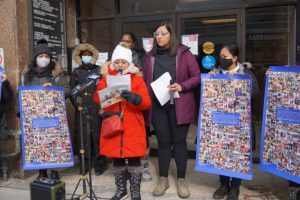On Family Day in Toronto: Migrant workers, mostly women, spend another day without families
On Family Day in Toronto: Migrant workers, mostly women, spend another day without families

Tina Weeska, a migrant care worker and mother from Indonesia, holds back tears as she says she misses her family (in the photo she is holding) with whom she has been separated for years now as she awaits the status of her application for permanent residence. Weeska joins million of migrant workers, students, refugees, families, and undocumented in Canada who have been separated from their families and have been celebrating Family Day away from them.
Photo by Veronica Silva Cusi
February 23, 2022
By Veronica Silva Cusi
The Philippine Reporter
LJI Reporter
Family Day was celebrated in many provinces in Canada last February 21. However, for millions of migrant workers and the undocumented, it was another day without the families they left behind to be able to work in Canada for a chance to give them a better future.
Some of them staged a protest in front of the office of Deputy Prime Minister Chrystia Freeland in downtown Toronto, Ont. Braving the winter cold but not able to hold back tears, most women participants shared their heartbreaking stories of family separation with only photos and memories of the families they left back home.
Tina Weeska of Indonesia; Queen Gabriel, a personal support worker from the Caribbean; Celia from the Spanish-speaking community; and Jhoey Cruz of the Philippines reiterated the call for permanent status, an advocacy of many migrant groups.
The protest action was organized by Migrant Workers Alliance for Change (MWAC), a migrant advocacy group that serves as secretariat of the Migrant Rights Network (MRN). They estimate that there are over 1.6 million people in Canada who are on temporary work and study permits or are refugee claimants or undocumented. In the meantime, there are 1.8 million applications for PR status in the backlog.
“Migrants are missing birthdays, anniversaries and funerals, which causes psychological and emotional distress, family breakdowns and crises,” the MWAC statement reads.
Cruz moved to Canada in 2016 after 12 years working as a nanny in Hong Kong. Ironically, like most migrant working mothers, she left behind her two children, the youngest one when only two months old, to take care of other children or families. Like many care workers documented in a report released in 2020, she was allegedly abused by her employer – made to work from 12 to 15 hours per day but paid only seven hours, slept in a stockroom without heater, and frequently intimidated.
Cruz said she opted to do care work in Canada because of the opportunity to bring her family over.

Deputy Prime Minister Chrystia Freeland
Ottawa, ONTARIO, Canada on 20 November, 2019.
© HOC-CDC
Credit: Mélanie Provencher, House of Commons Photo Services
Like some migrant workers, Cruz’ struggle to get PR status was hampered by changes in policies that carried different requirements.
For example, the caregiver program has undergone some many changes over the last few decades. She got a work permit under the interim pathway, which ended in 2019. Prior to this program, there was the live-in caregiver program which was closed in 2014. Currently, there are the Home Child-Care Provider Pilot (HCCP) and Home Support Worker Pilot (HSWP) for foreign caregivers.
“Pag mag-announce sila [ng new pathway] biglaan. Two weeks lang. Di ko makumpleto agad yung mga requirements. (When the government announces a new pathway [or policy], they give us only two weeks [to comply]. I can’t complete the requirements in that period),” said Cruz, who hails from Manila.
Some migrant workers’ hurdles are the requirements, such as English language proficiency and post-secondary education, in the case of under HCCP and HSWP. Some care workers find these requirements unreasonable.
“They [Canadian government] are asking for higher and higher education. If you are doing care work, you don’t need to be a university graduate,” said Cruz.
On the requirement to pass an English language requirement, migrant workers question why they still need this since they have been on the job for years, speaking the language. They claim that given that they can work in Canada means that they are able to communicate well in the workplace.
Last year, the federal government announced a program to give PR status to roughly 90,000 applicants. However, some migrant groups noted that many have also been left out because of the steep requirements.
To end the protest action, the group dropped in the mailbox envelopes of their family photos and posters addressed to members of parliament.
Immigration Plans 2022 – 2024
Meanwhile, MRN recently called out the Trudeau government for not including a pathway for undocumented, contrary to the mandate letter to Immigration Minister Sean Fraser.
On February 14, the Liberals announced that Canada would welcome 1.3 million permanent residents in the next three years. The 2022 – 2024 immigrant plan will see bulk of these new PRs coming from the economic class that includes skilled workers and businesses, provincial nominees and pilots, caregivers, and several other pilot programs, including the agri-food pilot.
However, MRN noted that the plan does not include the undocumented except for applications based on the humanitarian and compassionate grounds.
“The only pathway for non-status people is the Humanitarian and Compassionate application system, but it has only 8,250 spots [in 2022] while there are over half a million non-status people in the country,” the MRN wrote on MWAC’s website.
In the mandate letter to Fraser on December 16, Trudeau tasked Fraser to “build on existing pilot programs to further explore ways of regularizing status for undocumented workers who are contributing to Canadian communities.”
“For the over 1.6 million migrants in Canada without permanent resident status, and the rights that come with it, we simply cannot accept this ‘plan,’” MRN said in a statement following the announcement of the immigration plan.
For 2023 and 2024, the targets for H&C are 10,500 and 7,750, respectively.
Modernization
The immigration target was announced shortly after the modernization plan of the Immigration, Refugees and Citizenship Canada was announced.
On January 31, Fraser said the plan, funded at $85 million in the 2021 Budget, will “reduce application inventories.”



Comments (0)